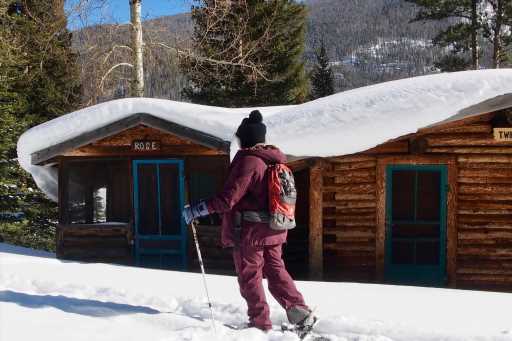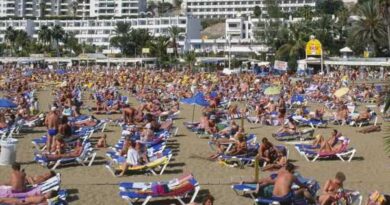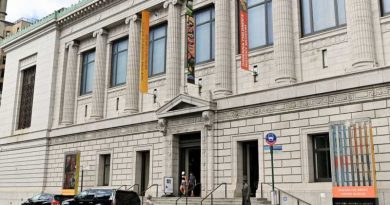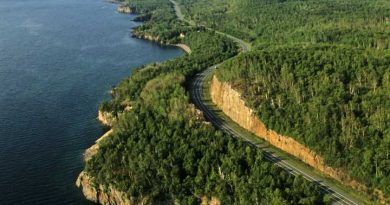Snowshoe trails at Rocky Mountain National Park: Pioneers’ cabins
A visit to snowy Rocky Mountain National Park is a must for every outdoor lover’s winter to-do list. Many of the same trails hiked in the popular seasons of summer and fall can be easily accessed in the frosty months of winter. The transformation of snow-clad trails offers a counterpoint to warm weather views, revealing painterly scenes of the park’s snow-fed glaciers, sugar-dusted mountains and white-blanketed valleys.
For those contemplating a winter visit, snowshoeing is a beginner-friendly to challenging-advanced activity that provides a chance to see the snowy wonders up close and at your own pace.
I am probably not the best touring companion for the fast-paced hiker or cyclist or even museum visitor. I’m more of a looky-loo explorer who stops and reads every sign on the trail and admires every interesting feature of a tree, leaf, animal track, fluttering bird, rock, stream, cloud — you get the picture. It irritates some and inspires others. That’s why beyond my basic knowledge of a place, I like to participate in small-group or private guided tours. My inquisitive mind wants answers and I learn something new every time. An experienced, well-trained guide can enhance the understanding of the landscape, while tripping the switch to a few “light bulb” bits of information in the brain that might transform my perspective.
On a recent visit to Grand Lake, I scheduled a snowshoe trip with Kaiyote Tours to explore the west side of Rocky Mountain National Park. I was looking forward to learning more about the natural history and homesteading lore of the area. Coincidentally, founder and owner Kaiyote Snow’s first name is pronounced the same as the animal coyote, which happens to correspond to the name of the great valley that spreads from north to south in the park, Kawuneeche, an Arapahoe term for “coyote valley.” She offers half-day snowshoe tours on the western side of the park that include snowshoes, poles and snacks. All tours are private.
“I don’t want to combine somebody who lives at sea level with somebody who might live at high elevation,” she explains. “So all my tours are private, we customize what the group or individual wants to do, whether it’s on the flats or more challenging trail.”
An abundance of credentials convinced me of her qualifications as a guide. For starters, she’s a self-taught naturalist with a bachelor’s degree. She’s also a graduate of the National Outdoor Leadership School and is a Leave No Trace Backcountry master educator. I instantly connected with her kind and positive demeanor and especially her passion for the more remote side of the national park.
If you go
Kaiyote Snowshoe Tours: kaiyotetours.com
Rocky Mountain National Park offers 2-hour ranger-led guided snowshoe tours on the west and east sides of the park: nps.gov
Grand Lake lodging/dining: gograndlake.com
The west side of RMNP receives fewer visitors than the east side near Estes Park. For Front Range residents it’s a bit farther drive to the western entrance near Grand Lake, with a few elements that may be sketchy — battling Interstate 70 traffic and crossing Berthoud Pass. But the benefits are many, including a spectacular scenic drive into Grand Lake. Flanked by snow-capped peaks, at 8,369 feet elevation, the town is a gem, perched along the shoreline of the largest and deepest natural lake in Colorado. On a bluebird day, the views take your breath away.
It was 10 on a cold, yet sunny Saturday morning as we motored toward the park, one of those incredibly gorgeous days that you wish for but don’t experience often enough. “Can you believe there is nobody on the road?” said Kaiyote, shaking her head. She looked at me with a smile, as if to confirm we were in for a treat. “On this side of the park you can show up anytime during the day and find a parking spot.”
The park road is plowed daily up to 12 miles. I thought about the east side of the park and how the Bear Lake parking lot likely was choked with cars and overflowing with people. I was filled with gleeful anticipation, like a kid ready to jump out of the family car at the amusement park. Snow on either side of the winding road sparkled like diamonds. And, for the moment, it was all ours.
Suddenly my mood shifted. The drive from the park entrance to the trailhead was sobering. Charred, skeletal trees spread across Harbison Meadow and the slopes in front of us, a visceral reminder of the devastation wrought by the October 2020 East Troublesome wildfire that raged through Grand County and swept into the park.
There’s no denying the elephant in the room — the forest, or lack of it. Although the fire burned a slim fragment of the park it is still a devastating sight. The burn scar flanks Trail Ridge Road from the entrance for about 5 miles into the park. Where there once was a tall green forest rolling across miles of terrain, the great expanse lays bare, opening up telescopic details showcasing the shape of the landscape. “You can really see the land now,” Kaiyote said. “All the rolling hills, the drainages and little geological features like the rock outcroppings before it was forest.”
It was a viewpoint I began to appreciate as I realized that each year the meadows and slopes will undergo a rebirth and become flush with new growth. In the beginning, an abundance of wildflowers will carpet the Kawuneeche. Eventually, another mixed conifer forest will fill in across the valley. The giant forest may not emerge in our lifetime but it’s important to remember that nature has its own timeline. A reminder of the origins of the park’s glacier-carved valleys, Kaiyote comments, “If we were here 20,000 years ago there would be no trees at all, we would be under glaciers.” She then pointed to a line of animal tracks. The distinct pattern of the footprints stitched across the snowbank between the charred trees leading up the bare slope as far as the eye could see. As we drove on, we saw lots of tracks, revealing the activity of wildlife — moose, mule deer, coyote, snowshoe hare.
There was one car in the parking lot of the Holzwarth Historic Homestead site, our destination for the snowshoe tour. From the trailhead, I could barely make out the collection of well-preserved, early-1900s cabins mingled among the lodgepole pine, aspen and Engelmann spruce trees half a mile away. For visitors interested in Colorado’s pioneers, the Holzwarth site offers a fascinating glimpse into the hardscrabble transition from ranching to mountain guest ranch tourism. Although there were a handful of guest ranches in the valley, the Holzwarth Homestead is the only remaining site of the era.
Subsistence ranchers and mining prospectors in the valley turned to mountain tourism as they discovered hearty travelers relished a warm bed and a home-cooked meal after crossing the mountains. These travelers, in the spirit of President Theodore Roosevelt, sought out the rugged and natural wilderness experience of the Kawuneeche Valley. In the 1920s, summer travelers came by horseback, wagon and Model A or T automobiles, ready to enjoy the hospitality of the Holzwarth family. Guests hiked in the fresh mountain air, enjoyed horseback rides and pack trips across the Continental Divide and fished in the Colorado River. Hearty appetites were rewarded with Mama Holzwarth’s tasty mountain meals, fueling up on trout, deer, grouse and chicken, baked goods, fresh eggs and milk, all cooked in the original cabin, now referenced as Mama Cabin, which I was looking forward to peeking at on our snowshoe walk.
Kaiyote pulled snack bars and “leave no trace” cards from a backpack decorated with colorful national park patches before we headed out on the trail. She gives all her guests a snack and a card that covers the 7 principles of Leave No Trace Center for Outdoor Ethics (lnt.org/why/7-principles). The principles emphasize ways people can care for the environment while spending time outdoors. We clickety-clack crunched across the snow into the valley.
“How deep do you think the snow is?” I asked Kaiyote. She stopped, twirled the top of a hiking pole down into the snow and dug it in. Pulling it out, she replied: “About 2 1/2 to 3 feet.”
It’s only a half-mile to the forested historic cabin site in the middle of the snow-blanketed valley. A gust of wind blew and my face bore the brunt of the frosty chill. I look at our gear — water-repellant, insulated, breathable jackets; insulated pants; insulated boots; wool hats, Gore-Tex gloves; polarized sunglasses — and wonder, “How did homesteaders survive this cold? What did they wear?” It was 25 degrees and sunny. It’s known to drop far below zero in the valley. I imagined a “Jeremiah Johnson” mountain man character tromping through deep snow while dressed in layers of skins and furs. Truth be told, that’s not far from the truth. Papa Holzwarth was known to wear a coat hand-sewn from the hides of two bison.
Along the trail there are signs detailing the area’s natural history, wildlife and lives of previous valley occupants. Although the burgeoning town of Grand Lake was fewer than 12 miles away, it would have seemed hundreds of miles away for these homesteaders. Yet while there surely were tough times and never-ending hard work, the location is stunning. Set along the vast Kawuneeche Valley, the cabins face the headwater drainage of the Colorado River. Behind them loom the Never Summer Range and the Continental Divide.
“Come over here and listen to the river!” Kaiyote called out. Carefully, I trekked over to a snowbank that revealed a portion of water. Soft gurgling sounds emanated from the water flowing under the snow. Kaiyote used the moment to explain how coyotes lean their heads to the ground to listen for voles, small rodents that live in tunnels underground. “Like a cat, they jump up and put their nose straight down in the snow and they come up shaking a vole in their mouth.”
Upon reaching the cluster of cabins, we circled around them — Mama’s Cabin, a taxidermy workshop, a woodshed, plus an ice house where Papa Holzwarth and his son Johnny stored carved ice from Grand Lake. The snow was deep and we nearly post-holed a few times. I imagined the aroma of Mama Holzwarth’s baked biscuits and fish frying on the stove. It was almost lunch time and we needed to head back. The only soul stirring was a coyote tracking near the woods. The half-day snowshoe trip went by quickly and my head was buzzing with the history of the Kawuneeche Valley, thanks to Kaiyote, and my eyes could not get enough of the natural beauty surrounding me.
Subscribe to our weekly newsletter, The Adventurist, to get outdoors news sent straight to your inbox.
Source: Read Full Article





